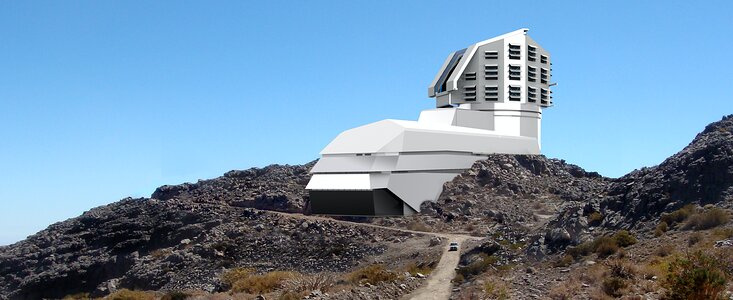LSST lays first stone
Construction starts; now one step closer towards better understanding of universe
14 April 2015
A new ground-based telescope promises unprecedented information about distant galaxies, nearby asteroids and even the mysterious dark energy that is accelerating the expansion of our universe.
Today, collaborators from the U.S. National Science Foundation (NSF), U.S. Department of Energy (DOE), Chile's Ministry of Foreign Affairs and Comisión Nacional de Investigación Científica y Technológica (CONICYT) and several other international public-private partners will gather outside La Serena, Chile, for a traditional Chilean stone-laying ceremony to celebrate the construction launch of the Large Synoptic Survey Telescope (LSST).
The LSST will be an 8-meter wide-field survey telescope that will image the entire visible sky a few times each week for 10 years, providing an unprecedented amount of information while transforming the emerging discipline of data-enabled science. It is expected to see first light in 2019 and begin full operation in 2022.
"Today, we embark on an exciting moment in astronomical history," said NSF Director France A. Córdova, an astrophysicist. "NSF is thrilled to lead the way in funding a unique facility that has the potential to transform our knowledge of the universe."
Equipped with a 3-billion pixel digital camera (the world's largest digital camera), LSST will observe objects as they change or move, providing insight into short-lived transient events such as astronomical explosions and the orbital paths of potentially hazardous asteroids. LSST will take more than 800 panoramic images of the sky each night, allowing for detailed maps of the Milky Way and of our own solar system and charting billions of remote galaxies. Its observations will also probe the imprints of dark matter and dark energy on the evolution of the universe.
"We are very excited to see the start of the summit construction of the LSST facility," said James Siegrist, DOE associate director of science for high-energy physics. "The LSST's digital camera--which is DOE's responsibility--will shed light on the nature of dark energy, the name we give to the mysterious force accelerating the universe's expansion. By collecting a unique dataset of billions of galaxies, LSST will provide multiple probes of dark energy, helping to tackle one of science's greatest mysteries."
NSF and DOE will share responsibilities over the lifetime of the project. The NSF, through its partnership with the Association of Universities for Research in Astronomy (AURA), will develop the site and telescope, along with the extensive data management system, as well as coordinate education and outreach efforts. DOE, through a collaboration led by its SLAC National Accelerator Laboratory, will develop the large-format camera.
In addition, the Republic of Chile will serve as project host, providing (and protecting) access to some of the darkest and clearest skies in the world over the LSST site on Cerro Pachón, a mountain peak in northern Chile. The site was chosen through an international competition due to the pristine skies, low levels of light pollution, dry climate and the robust and reliable infrastructure available in Chile.
"Chile has extraordinary natural conditions for astronomical observation, and this is once again demonstrated by the decision to build this unique telescope in Cerro Pachón," said CONICYT President Francisco Brieva. "We are convinced that the LSST will bring important benefits for science in Chile and worldwide by opening up a new window of observation that will lead to new discoveries. By 2020 our country is expected to concentrate 70 percent of the world's astronomical infrastructure, and in this process the collaboration and trust of institutions like NSF and AURA is vital."
"This is not just another telescope," said Diane Souvaine, Tufts University vice provost for research and former National Science Board (NSB) chairman of the Committee on Programs and Plans. "What makes LSST so exciting is a data set that will be immediately available to scientists and the general public. Tens of thousands of transient events each night will be available to the entire world, reaching social networks, citizen scientists, and students everywhere. This instrument will leave an unparalleled legacy of data and lives touched."
The NSB voted to approve the LSST project in August 2012, clearing the way for NSF to include funds for construction in NSF's annual budget request. Private donors, including the Charles and Lisa Simonyi Fund for Arts and Sciences, and Bill Gates, also played a critical role in supporting LSST construction. A complete list of LSST institutional members is online.
Contacts
Ivy F. Kupec
NSF
Tel: (703) 292-8796
Email: ikupec@nsf.gov
Nigel A. Sharp
NSF
Tel: (703) 292-4905
Email: nsharp@nsf.gov




